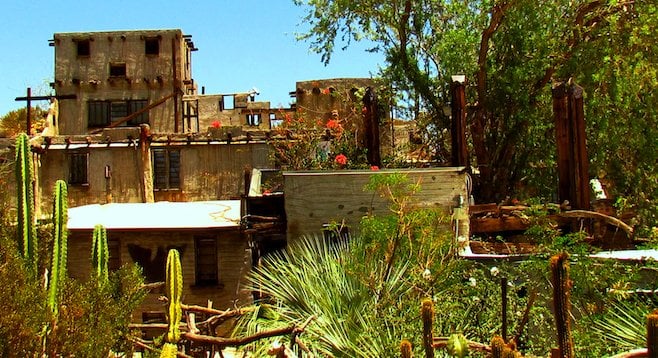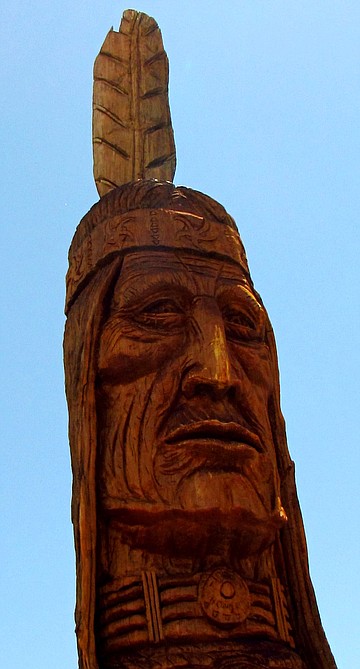 Facebook
Facebook
 X
X
 Instagram
Instagram
 TikTok
TikTok
 Youtube
Youtube

I’m in love with a dead man.
Honestly, if there ever was a Man of Men to pine for, it would be Cabot Yerxa, who died three years after I was born. Not only was he dreamy handsome (imagine a blend of Robert Redford, Alex Pettyfer and Paul Bettany), but there wasn’t anything he couldn’t do.
The Man, The Myth
Rumored to be a descendant of Newfoundland’s founder John Cabot, as a fearless adventurer Yerxa dared the wilds of Alaska during the gold rush when he was 16 and political unrest in Cuba when he was 19. He traveled the world, landing in Paris, where he enrolled at the Academie Julien. He painted impressionistic Southwest scenes using his own pigment recipes, which he sold on postcards to passengers at the Garnet train depot outside Palm Springs. He was also a newspaper columnist and an adept linguist who spoke many Native American dialects. He even compiled a 320-word vocabulary of the Inuit language, which was promptly purchased by the Smithsonian Institute.
An enterprising entrepreneur, Yerxa made fortunes on a number of ventures, including a mobile grocery, tract housing and cigar manufacturing. He invested everything into his father’s California citrus orchard – only to lose it all in the 1913 freeze that decimated groves across the state.
The Miracle
A year later, he stumbled upon a hill north of Palm Springs that was sliced by the San Andreas Fault. It spurted hot mineral water from one side and cold water from the other.
Recognizing the potential of the springs, which percolated at temperatures up to 180 degrees, Yerxa spent the last twenty years of his life singlehandedly constructing the four-story, 35-room pueblo-style building on his property on “Miracle Hill” to accommodate the tourists he knew would come.
And they did. By the 1950s, the town just north of Palm Springs with award-winning drinking water and non-sulfuric therapeutic springs had become a hot spot for celebs and city escapees.
Today, there are 20 boutique-style spa hotels in the town of less than twenty thousand residents – a quarter of the number in operation during its boomtown heyday, just a few decades earlier. It's an easy two-and-a-half-hour drive from San Diego.
A Visit to the Springs
Standing at the locked wooden door in the adobe wall encircling Hacienda Inn in Desert Hot Springs, I listened to the sound of water trickling.
The door swung open to the bright smiling face of the Brit-born onsite manager, who promptly led me through the cloistered, terraced garden with hot-spring-fed pool, hot tub and waterfall, then past nooked outdoor dining areas, fireplaces and an expansive open-air kitchen interwoven into a lush, stunning garden. As if that in itself wasn’t heaven, I entered the French doors to my room and crossed it to reach another set of French doors that opened onto a private walled patio, complete with hammock.
As I kicked off my shoes and stripped from my dusty hiking clothes to put on my bathing suit, eager to have a nice long soak in the hottest pool out there, I heard the prettiest fingerpicking I've heard in a long, long time. One of the two other guests there played the guitar masterfully.
While I was in the hot tub, the host brought over a glass of wine. The music drifted through my neighbor’s open windows and lulled me as I absorbed my beautiful surroundings and slowly melted into nothingness. Why would anyone ever leave the place, I wondered. And honestly, I think that’s the point to the continued success of this otherwise unimpressive desert town.
Waokiye and Cabot's Pueblo
Aside from the town itself, Desert Hot Springs has more to offer than just healing waters. The 40-foot-tall, 20-ton Waokiye, carved by Peter Wolf Toth from a 750-year-old sequoia, stands sentinel over Yerxa’s incomplete 5,000-square-foot pueblo.

This Sioux Indian chief statue (left) is the 27th of 70 statues included in Toth's Trail of Whispering Giants. (The first in the series, coincidentally, was carved in 1972 into a sandstone cliff at the base of Windansea Beach in La Jolla.)
Yerxa's pueblo is now a museum offering guided tours for $10 year-round. To construct the abode, he collected driftwood, old telephone poles and fencing from as far as the Salton Sea and scavenged the desert for broken glass and even old wagons. Listed on the National Register of Historic Places, it's open Wednesday through Saturday from 9:00 a.m. to 1:00 p.m.
Access to both the grounds and Toth’s carving is free.


I’m in love with a dead man.
Honestly, if there ever was a Man of Men to pine for, it would be Cabot Yerxa, who died three years after I was born. Not only was he dreamy handsome (imagine a blend of Robert Redford, Alex Pettyfer and Paul Bettany), but there wasn’t anything he couldn’t do.
The Man, The Myth
Rumored to be a descendant of Newfoundland’s founder John Cabot, as a fearless adventurer Yerxa dared the wilds of Alaska during the gold rush when he was 16 and political unrest in Cuba when he was 19. He traveled the world, landing in Paris, where he enrolled at the Academie Julien. He painted impressionistic Southwest scenes using his own pigment recipes, which he sold on postcards to passengers at the Garnet train depot outside Palm Springs. He was also a newspaper columnist and an adept linguist who spoke many Native American dialects. He even compiled a 320-word vocabulary of the Inuit language, which was promptly purchased by the Smithsonian Institute.
An enterprising entrepreneur, Yerxa made fortunes on a number of ventures, including a mobile grocery, tract housing and cigar manufacturing. He invested everything into his father’s California citrus orchard – only to lose it all in the 1913 freeze that decimated groves across the state.
The Miracle
A year later, he stumbled upon a hill north of Palm Springs that was sliced by the San Andreas Fault. It spurted hot mineral water from one side and cold water from the other.
Recognizing the potential of the springs, which percolated at temperatures up to 180 degrees, Yerxa spent the last twenty years of his life singlehandedly constructing the four-story, 35-room pueblo-style building on his property on “Miracle Hill” to accommodate the tourists he knew would come.
And they did. By the 1950s, the town just north of Palm Springs with award-winning drinking water and non-sulfuric therapeutic springs had become a hot spot for celebs and city escapees.
Today, there are 20 boutique-style spa hotels in the town of less than twenty thousand residents – a quarter of the number in operation during its boomtown heyday, just a few decades earlier. It's an easy two-and-a-half-hour drive from San Diego.
A Visit to the Springs
Standing at the locked wooden door in the adobe wall encircling Hacienda Inn in Desert Hot Springs, I listened to the sound of water trickling.
The door swung open to the bright smiling face of the Brit-born onsite manager, who promptly led me through the cloistered, terraced garden with hot-spring-fed pool, hot tub and waterfall, then past nooked outdoor dining areas, fireplaces and an expansive open-air kitchen interwoven into a lush, stunning garden. As if that in itself wasn’t heaven, I entered the French doors to my room and crossed it to reach another set of French doors that opened onto a private walled patio, complete with hammock.
As I kicked off my shoes and stripped from my dusty hiking clothes to put on my bathing suit, eager to have a nice long soak in the hottest pool out there, I heard the prettiest fingerpicking I've heard in a long, long time. One of the two other guests there played the guitar masterfully.
While I was in the hot tub, the host brought over a glass of wine. The music drifted through my neighbor’s open windows and lulled me as I absorbed my beautiful surroundings and slowly melted into nothingness. Why would anyone ever leave the place, I wondered. And honestly, I think that’s the point to the continued success of this otherwise unimpressive desert town.
Waokiye and Cabot's Pueblo
Aside from the town itself, Desert Hot Springs has more to offer than just healing waters. The 40-foot-tall, 20-ton Waokiye, carved by Peter Wolf Toth from a 750-year-old sequoia, stands sentinel over Yerxa’s incomplete 5,000-square-foot pueblo.

This Sioux Indian chief statue (left) is the 27th of 70 statues included in Toth's Trail of Whispering Giants. (The first in the series, coincidentally, was carved in 1972 into a sandstone cliff at the base of Windansea Beach in La Jolla.)
Yerxa's pueblo is now a museum offering guided tours for $10 year-round. To construct the abode, he collected driftwood, old telephone poles and fencing from as far as the Salton Sea and scavenged the desert for broken glass and even old wagons. Listed on the National Register of Historic Places, it's open Wednesday through Saturday from 9:00 a.m. to 1:00 p.m.
Access to both the grounds and Toth’s carving is free.
Comments